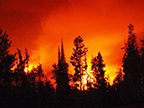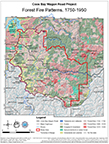|
About |
|
|
Oregon Websites and Watersheds Project, Inc. |
|
|
Online Tools for the Study and Stewardship of Oregon's Watershed Resources |
|
|
About |
|
|
Oregon Websites and Watersheds Project, Inc. |
|
|
Online Tools for the Study and Stewardship of Oregon's Watershed Resources |
|
Oregon Websites and Watersheds Project. Inc. (ORWW) is an educational, nonprofit 501 c(3) corporation founded in Philomath, Oregon in December 1996. ORWW is funded by private businesses, landowners, individuals, associations, and foundations with an interest in the long-term use and scientific management of Oregon's natural and cultural resources. The goals and objectives of ORWW, a brief organizational history, and a list of current board members can be found at www.ORWW.org/Mission.htm.
Mission Statement
Oregon Websites and Watersheds Project, Inc. shows students how to use Internet communications and scientific methodology to help manage Oregon's natural and cultural resources. Students are encouraged to use computer technology, historical documentation, scientific reasoning, community outreach, environmental enhancement projects, and effective long-term monitoring strategies to help make decisions which affect Oregon's quality of life.
[EARLY ORWW PROJECT HIGHLIGHTS: 1996-2001]
[FIRST TEN YEARS OF ORWW PROJECTS: 1996-2006]
[RECENT ORWW PROJECTS: 2007-2017]
[CONTEXTUAL TIMELINE OF ORWW PROJECTS: 1995-2015]
Project Websites: 1996-2006. ORWW websites have been largely designed and built by Oregon schoolchildren and adults: from Siletz School 2nd Grade students to Oregon State University graduate students; from 1996 until the present time. An estimated 80% of the website's content is student projects that have been continuosly online since they were created. Most of the work these first 10 years has been completed by Benton, Harney, Lincoln, and Multnomah county high school and college students and their teachers, with the help of ORWW workshops, field trips, lectures, mentoring programs, teacher training, and other technical assistance. These projects are designed as works in progress that are intended to be updated and improved from time to time by future students, teachers, and website administrators. By June 2006, more than 150,000 visitors a year were using ORWW websites' files [2016 Note: link broken and needs to be repaired], at a steady rate of 250 to 550 visitors a day, seven days a week. Visitors in the last year downloaded between three and five gigobytes (GB) of files a month, totaling more than 45 GB a year of shared educational files regarding Oregon's natural and cultural resources. Many visitors arrived daily by following Google, Yahoo, MSN, or other search engines via thousands of keywords regarding Oregon's schools, rivers, forests, farms, history, wildlife, and other environmental resources. Others are regular users, such as teachers, student project participants, sponsors, and people with an interest in learning more about Oregon via the Internet. All are beneficiaries of the fine design and workmanship of hundreds of Oregon students and teachers.
["10 YEARS in 30 SECONDS" -- first ORWWmedia YouTube video, launched January 16, 2008 and produced by long-time ORWW contributor, Josh Meredith Dot Com]
|
|
PEAS Project (Philomath, Eddyville, Alsea, and Siletz Environmental Education Project ) demonstrated the usefulness of Internet communications for studying local environmental science projects in five rural Oregon schools. |
1996 |
|
|
Classroom on the Siletz River Day became a popular annual event, linking Siletz School, local businesses, agencies, landowners, families, teachers, and members of the Siletz Tribe along the river and on the Internet. |
1997 |
| The Willamette River Steelhead Project provides a framework for local students to help study, evaluate, monitor, and enhance Multnomah County's anadromous fish populations and river water quality. |
1998 |
|
|
The Oregon Lynx website was a popular searchable database of useful links & information specific to Oregon Schools, River Basins, Libraries, Museums, Media, Governments, Landowners, and Special Interests. Google did it better and this site was never fully completed, despite heavy international usage of Schools, Rivers, and Cities databases for several years. |
1999 |
|
|
The 2001-2002 Oregon School Website Award competition recognized the State’s best School websites. Certificates and cash prizes were awarded to top 20 Oregon schools for developing winning websites, with particular emphasis on design, environmental sciences content, and public outreach. |
2000 |
|
| The Harney County Cattle Grazing Study showcases student reports on the benefits and effects of cattle grazing in Harney County. The website is designed to share student findings for purposes of peer review, public education, and local resources management. |
2001 |
|
|
Benton County Swimming Holes is a Philomath HS senior science project by Sharon Sternadel. This site shows appearance, location, and water quality of community swimming holes on the Long Tom, Luckiamute, Marys, and Alsea rivers in Benton County. |
2002 |
|
| The Bald Hill Native Plants website was created to record seasonal changes in native plant populations over the course of a year in a Willamette Valley public park. The Native Plants Tour remains one of our most visited and downloaded sites. | 2003 |
|
| ORWW designed and hosted the first Marys Peak Interpretive Center (MPIC) website as a public outreach and digital archive service for their initial summer science lecture series. "Ryan's Snakes" remains a popular video clip and is often downloaded several times a month. | 2004 |
|
| The B&B Complex website was constructed for several purposes, including immediate public outreach, systematic documentation of landscape-scale disturbance patterns, and long-term public monitoring framework. |
2004 |
|
| Oregon Experts was created as an index to better locate video clips, reports, and other online ORWW files that have been created as a result of student projects. These files feature the skills, thoughts, and observations of many influential and knowledgeable Oregon citizens. | 2004 |
|
| The Brandis Oaks Savannah Restoration website was created by two Crescent Valley HS students from a formal oak restoration plan. It is intended to guide and archive student research findings for this Benton County project. | 2005 |
|
| The Babyfoot Lake website was created in response to a logging error widely reported in local and national media in August 2005. Its purpose is to establish a long-term monitoring and assessment project for local HS and CC students. |
2005 |
|
[2016 Note: Deer Creek Flash icon dysfunctional] |
The 2005 Deer Creek Fire near Selma, Oregon was quickly contained and suppressed by rapid firefighter response and by a change in local weather conditions. What is the long-term effect of wildfire suppression? Extensive use of digital video, QTVR, and Flash software to document this event. | 2005 |
| The Oregon Wildfires website was created as an index to begin consolidating educational topical event websites around the State, including B&B Complex, Biscuit, and Deer Creek wildfires of the early 21st century. | 2005 |
|
| The Kalapuya-Amin ("Land of the Kalapuya") website is devoted to a three-day symposium regarding the land management and resource use technologies of Kalapuya people in the Willamette Valley, Oregon in 1450 and in 1750. |
2006 |
Early Project Highlights: First Five Years (1996 - 2001). ORWW websites have been continuously online since the first PEAS Project files were uploaded in January 1997. At the end of the school year the PEAS Project Award ceremony was broadcast live via the Internet from Philomath MS gymnasium; several years in advance of Bill Gates' subsequent, more famous, live Internet broadcast. Local and statewide media and national politicians recognized the value of this emerging concept and capability: using statewide urban-rural Internet communication and computer technology networks to efficiently conduct scientific peer review, archive student findings and other data, publicly monitor long-term environmental enhancement projects, and document educational processes over space and time. Now it was possible to learn and teach about Oregon's natural and cultural resources from a common source at any time or place, so long as Internet communications were available. The following links are connected to important milestones and highlights of ORWW's first years of existence.
| ORWW projects have been featured in news articles (Feb., 1997), supported by both State Senators (1997-1998), and featured on statewide television news (KATU: May 6, 1999). | |
| PEAS Project Survey of Rural School Internet Connectivity, 1996-1997. Two of the three PEAS Pilot newsletters are available online, including this tabular summary of the first PEAS computers and their Internet capabilities (January 31, 1997). | |
| Eddyville High School Homepage Eddyville HS was an original PEAS Project participant. This site features the first student designed and built ORWW webpage (February 12, 1997). | |
|
|
Salmon Cycle - Ms. Henderson's Siletz GS 2nd Graders' completed the first student ORWW web report, and received international guestbook visits (May 7, 1998). |
|
|
1939 Indexed Aerial Photos of the Siletz River Basin Scanning, linking, and online placement of historical photos by Eddyville HS Senior, Erik Badzinski (August 27, 1998). |
| Alsi Indians - Alsea HS Kingfisher #13 report on local precontact and early historical people of the Alsea River basin. First online version of Kingfisher, by Alsea HS Junior. | |
| (WRI) Restoration Program Inventory Report to Oregon Governor John Kitzhaber includes detailed information on ORWW and its projects, including goals, budgets, objectives, sponsorship demographics, etc. (June, 2000 update). | |
|
Chinook Salmon Release North Portland students from several local schools raised salmon fry from eggs, then released the fish into the Willamette River (January 26, 2001). |
|
|
Oregon School Website Awards ORWW awarded certificates to more than 20 of the best 2001-2002 Oregon school websites, and awarded more than $5,000 in cash prizes to winning schools. Awards were for setting statewide standards in a new medium (June 10, 2002). |
Recent Project Websites: 2007-2017. ORWW websites shifted focus in the second decade of its operations from being mostly constructed via Internet-based student environmental science research/training projects to mostly developing educational content by demonstrating research methods that can be replicated in both field and classroom environments. This change in focus was largely a result of two factors: a sudden and prolonged decrease in ORWW annual operating income (predictably beginning in 2008 and continuing for several years) and the increased sophistication and widespread use of Internet communications via smartphones, laptops, and tablets -- students didn't need introductions and training anymore, they just needed to be left alone to their own devices.
By 2008 ORWW received its 3 millionth "unique visitor," if not a year or two before then. By that time traffic was beginning to noticably slow and shortly thereafter we stopped tracking our site usage: it was becoming too complicated to filter out all of the "noise" from the robotic search engines and archival software that had been flooding the Internet in previous years; and our change in focus became more concerned with developing local environmental sciences content for much smaller and more invested audiences -- typically Oregon tribes, rural counties, and inner-city neighborhoods. As with our earlier efforts, "these projects are designed as works in progress that are intended to be updated and improved from time to time by future students, teachers, and website administrators."
ORWWmedia was also launched by ORWW in 2008. Considerable effort was initially put into this development, partly in hopes of generating donated revenue, but the channel has been relatively inactive for several years since. Despite the lack of recent ORWW student use and lack of income generation, ORWWmedia still has a regular stream of viewers of its listed 38 videos. At this time (September 6, 2016), the channel has had more than 115,000 video views since its creation, with the actual number of "unique visitors" being a significant fraction of that total.
For most of the past 10 years, however, online traffic at ORWW has been a small fraction of the large numbers of "unique visitors" that the site experienced during its first decade of existence. As described above, this is largely a result of changed focus of the website -- partly due to changed economic conditions and partly due to changed patterns of Internet use: e.g., developing classroom environmental sciences projects as a visiting lecturer/project leader is time-consuming and increasingly more problematic and expensive, due in part to increasingly costly child safety and insurance concerns; while almost everyone at this time -- including students -- has a smartphone and most people also own and/or are proficient on a personal computer. Basic student training now is focused more on social networking etiquette, email business communications, and website design rather than how to browse the Internet, scan a document, or use a digital camera when those were still emerging technologies.
Too, when Google, Alta Vista, Yahoo!, etc., search engines were competing for users and developing their functional criteria in the late1990s and early 2000s, there were far fewer websites in existence, a very small fraction of today's content online, and a nearly nonexistent advertising competion for the "thousands of keywords regarding Oregon's schools, rivers, forests, farms, history, wildlife, and other environmental resources" that now put ORWW far down the list. In 1998 a search for "salmon cycle," for example, listed the PEAS Siletz 2nd Graders' report on this topic in the top 3 to 5 links (depending on the search engine used), and usually far ahead of anything from the US Fish & Wildlife Service, OSU, or Oregon Department of Fish & Wildlife -- if anything at all from these sources. Today there are likely thousands of "salmon cycle" links on Google or Yahoo! listed ahead of the Siletz report; yet, a more geographically-specific Google search of "Siletz River salmon cycle" at this time (September 6, 2016) still lists the 1998 ORWW link fifth!
Next year, 2017, marks another transitional time in ORWW history. Several of our original board members are getting older and beginning to retire and decisions are being made on how to best update, archive, and keep in active use this entire 20-year collection of ORWW websites. As this process is being organized and completed, another strategy is being developed on how to best apply this information in the future and what that direction might mean for refining and renewing ORWW projects, methods, and leadership.
| 2006 | The Osbornes Project | This project was initiated by Oregon State University (OSU) Forestry student, Judd Lehman. The focus is to replicate ("repeat photography") and upload selected 360-degree landscape photographs, based on the hundreds of such "Osborne Photographs" taken in the 1930s from US Forest Service Fire Lookouts for comparative purposes.. | |
| 2007 | Owl Ridge Trails Project | This research project was initiated by the Confederated Grand Ronde Tribes for purposes of learning more about their ancestral history; in this instance, the precontact travel routes and resource uses of the Molallan people and others in the headwaters of the South Santiam and Blue River headwaters. | |
| 2007 | Southwest Oregon History | This project was commissioned by Dr. Mike Newton of the OSU Forest Sciences department to research the landscape history of several long-term research plots he had established on Bureau of Land Management forestlands in the Applegate and Cow Creek valleys of SW Oregon. | |
 |
2008 | ORWWmedia YouTube Channel | The ORWWmedia YouTube Channel was launched January 16, 2008 by ORWW. It contains a selection of 38 ORWW educational video clips that focus on Oregon's natural and cultural resources. As of August 2016 it has had more than 115,000 views, despite being largely inactive for several years. |
| 2008 | Gordon Meadows Restoration Plan | This restoration plan was commissioned by the Confederated Tribes of Grand Ronde as a result of Owl Ridge Trails Project findings. It was presented at the 2010 NW Chapter of Society of Ecological Restoration annual conference as a 34-slide Powerpoint. The plan has yet to be formally adopted or implemented by the US Forest Service. | |
| 2008 | Biscuit Fire Civic Science Proposal | The intent of this project was to design & create a stable, independent website that could serve as a principal source of post-Biscuit Fire data for study collaborators & interested public; as an interactive “civil science” & monitoring tool; & as a basis for formal science research & teaching curricula. |
|
 |
2009 | Wildfire Economics | This project offers a developing method to better account for the wide range of actual costs & losses associated with large-scale wildfire damages (typically 10-50 x media reported suppression costs) in order to lessen their impacts via better preparedness, improved fire management strategies, & more efficient mitigation actions. |
| 2009 | Owl Ridge Trails Oregon Heritage Excellence Award | 2009 Oregon Heritage Excellence Award.given by Oregon Heritage Commission (OHC) in Portland, Oregon, April 17, 2009. Award accepted by Dr. Zybach on behalf of ORWW & Confederated Tribes of Grand Ronde. Award presented by George Kramer, OHC Chair, and "Oregon First Lady," Mary Oberst, for 2008 ORWW Owl Ridge Trails Report. | |
 |
2009 | Coos Bay Wagon Road Lands History | This research report was prepared for the purpose of better understanding the role of Native people in the forest and fire history of the Coos Bay Wagon Road (CBWR) Lands. It was written br Drs. Zybach and George Wasson for the Coquille Indian Tribe to document the history of Tribal forestlands, but has never been publicly released. |
| 2010 | Upper South Umpqua Headwaters | The purpose of this study was to produce a reliable landscape-scale description of late precontact (pre-1826) "reference forest conditions" for the eastern portion of present-day Tiller Ranger District of the Umpqua National Forest in Douglas County, Oregon. The primary intended use of the information was to help update Community Wildfire Protection Plans. |
|
| 2011 | Coquelle Trails Project Online | This project originally started in 2006 by Chief Don Ivy to investigate & publish a “cultural geography” of the Coquille Indian Tribe; a description of physical landscape & geographic area occupied or used by Ancestors of modern Coquille Tribe prior to -- and at time of -- earliest reported contacts with Europeans & Euro-Americans, 1826 through 1856. Website launch included links to two-volume project report by Zybach & Ivy PDF files. | |
| 2012 | 1855-1856 Oregon Indian War in Coos County | Nearly forgotten story of systematic “ethnic cleansing” of the Coos, Coquille, Chetco, Elk, Floras Lake, Sixes, Umpqua, and Rogue River watersheds of southwest Oregon Indian families from October 1855 through July 1856. It is repeated verbatim here entirely through eyewitness accounts of more than 35 participants & observers and through subsequent writings of three early historians. | |
 |
2012 | Cottage Grove History | A collection of digitized historical maps, articles, photographs, and reports written and assembled by Dr. Zybach for local Cottage Grove newspaper and as a member of the City's Urban Forestry Committee and Historic Resources Commission. |
| 2013 | Wayne Giesy Receives National SAF Award | Wayne Giesy displays Oregon Society of American Foresters (SAF) Honorary Membership certificate for lifetime achievement in forestry, given at annual SAF State meeting in Pendleton, Oregon, April 25, 2013. On October 24, 2013, Giesy also received national SAF award in Charleston, South Carolina for his lifetime contributions to forestry & forest policy. | |
 |
2013 | Letitia Carson in Oregon, 1845-1888 | Letitia Carson was a slave born in Kentucky about 1815 who crossed the Oregon Trail in 1845 with her naturalized Irish mate, giving birth to their first child along the way. Carson's story after she reached Oregon is just as amazing. This research was the basis for Jane Kirkpatrick's award-winning historical novel, Light in the Wilderness, and for the Facebook page, Friends of Letitia Carson. |
 |
2014 | 1992 Alberta Street Project Revisited | 1992 Alberta Street Report in N/NE Portland was focus of historical research by local African American HS students. Research methods and recommendations were replicated and updated to 2015 Project Report. Community outreach developed with Alberta Street Facebook Page. |
| 2015 | Camas Colors Project | Were aesthetic qualities of camas blossom colors a factor in establishment and/or maintenance of camas fields by precontact western Oregon Indian communities? Research is based on observation that distinctive colors of camas blossoms appear to geographically correlate to early historical Indian communities in the Willamette and Umpqua river valleys. | |
 |
2016 | Catastrophic Wildfires of the Douglas Fir Region, 1700-2016 | This website is currently under construction and is the principal research project being undertaken by ORWW during the 2016 calendar year. To this point documentary information has been gathered regarding more than 170 forest fires in western Washington, western Oregon, and northern California exceeding 10,000 acres in size and occuring from 1700 through 2016. |
 |
2017 | ORWW PEAS Project 20th Anniversary! | The PEAS (Philomath, Eddyville, Alsea, and Siletz Schools) Project was the first educational website created by ORWW. It was launched January 15, 1997 and has grown steadily ever since. The year 2017 will mark 20 consecutive years for the www.ORWW.org website being continuously online -- likely the oldest independent educational website in existence. |
Contextual Timeline of ORWW Project Websites: 1995-2015
ORWW produced some of the very earliest environmental sciences content on the Internet and is likely the oldest nonprofit educational website in continuous operation -- and particularly when considering it still uses its original webpage and navigational designs, still contains all original content that has been steadily uploaded over the years, and still continues to grow and expand every year. As a result of ORWW projects, rural and inner-city Oregon students have been among the first: to regularly use Internet communications during the course of their studies; to develop an inter-school Internet network and live broadcast an event; to transmit and upload digital photographs and videos to the Internet; and to research and document the history and resources of their own communities on the worldwide web. To put these achievements in context, here is a timeline of ORWW's historical markers in comparison with those of current Internet leaders Yahoo!, Google, and YouTube:
January 18, 1995: Yahoo! founders create the yahoo.com domain name.
January 15, 1997: ORWW launches its first educational website, The PEAS Project.
June 6, 1997: The PEAS Project's 5-school network broadcasts a live event from Philomath Middle School over the World Wide Web, using HTML text and digital photographs, via a personal computer with a 28.8 mb. modem and 16 mb. of RAM.
August 29, 1997: ORWW receives 501 c(3) educational nonprofit status from IRS.
July 28, 1998: ORWW begins construction of an Oregon-centric topical Search engine with the "OR Lynx Project."
August 31, 1999: Google Inc. files its first patent with the US Patent office.
April 17, 2002: Students from Harney County create documentary videotapes of their Harney County Cattle Grazing Study field trip to the Columbia Gorge, Portland, and Willamette Valley and put them online, marking the first time rural ORWW schools have had capability to upload and play video.
February 5, 2005: www.youtube.com is activated.
November 13, 2007: Google acquires YouTube.
January 16, 2008: ORWWmedia becomes one of the first 300 Youtube Channels to register as a 501 c(3) nonprofit and uploads several videos from its six-year 2002-2008 online inventory.
October 20, 2015: ORWW publishes online report replicating the Methods and comparative findings of 1992 African American student research project 23 years later: the 2015 Alberta Street Project in N/NE Portland.
© 1996-2017 Oregon Websites and Watersheds Project, Inc. & NW Maps Co.